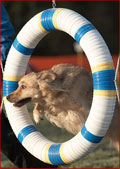5 Winter Paw Tips
Keep Your Dog's Nails Trimmed
Long nails will make your dog's toes spread when he walks, so giving more room for snow and ice build up between his toes. This can make walking painful for your dog - try walking with cotton wool between your toes and you'll get an idea of what your dog would be experiencing.
Unclipped nails also affect your dog's weight distribution, pushing his weight onto the back of his feet. This means he'll have less traction and will be more likely to slip and injure himself when he's walking on an icy path.
Trim the Fur Between the Toe Pads
Slushy snow tends to stick to dog fur, and salt and grit may be mixed up in the slush.
By keeping the fur between the pads level with the pads themselves you'll reduce the amount of snow clinging to your dog's fur. Compacted snow, grit and salt on the bottom of your dog's feet will make walking difficult for him, and affect his ability to stay on his feet. Remember how snow gets compacted on the bottom of your boots and the tread no longer stops you from slipping - your dog will be experiencing something similar.
Regularly Check Your Dog's Pads
De-icers are primarily made from rock salt, and salt can cause your dog's pads to dry out and crack. Snow, grit and de-icing products can accumulate in these cracks and contribute to blisters, sore pads and infections.
You can apply Vaseline or a foot balm to your dogs pads to prevent them drying out and to keep them supple.
It's a good idea to check your dog's paws daily for any abrasions, cracked pads and grit stuck between his toes and treat dog paw injuries promptly.
Wash Your Dog's Paws When You Get Home
Washing your dog's paws in warm water when you get home serves several purposes:
it'll warm his feet up;
any salt or deicing chemicals will be washed off - if you don't do this and your dog licks his paws he may suffer vomiting and diarrhea from the ingested chemicals; and
dissolve any ice that's formed between his toes.
Consider Buying Your Dog Some Booties
Dog boots are a really good investment - they will protect your dog's feet from salt, chemical de-icers and grit and help to retain body heat.
In my article about frostbite and hypothermia I mentioned that one of the ways your dog quickly loses body heat is through his paws as they come into contact with the cold ground. Investing in booties will help your dog to retain body heat, thereby lowering the risk of hypothermia.
There are a number of dog boot manufacturers and your local pet shop should have some for you to choose from, or you could try making your own.
It's not natural for your dog to wear shoes, so get him used to wearing them in the house for short periods of time giving lots of praise as he walks around in them.
Try and treat your dog's feet like your own - when our feet get cold, sore and blistered they are painful to walk on and it makes us feel miserable. Remember that your dog feels the same way.
From:DogTopics.com







 Ontario Dog Sports
Ontario Dog Sports
Reader Comments